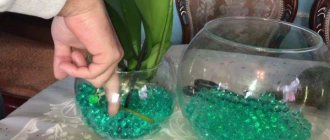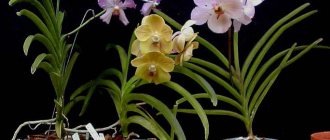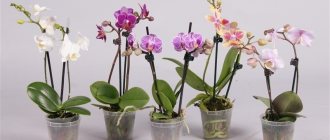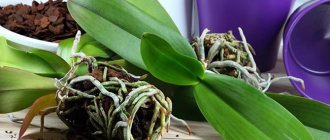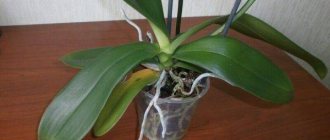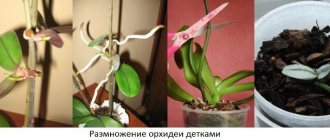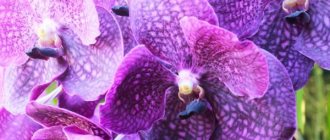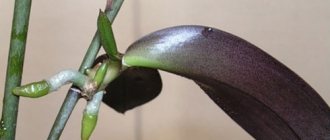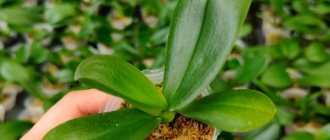This technique is competitive, and now experienced gardeners are using it in practice when growing orchids.
In order for the plant to develop well, must be properly planted in a closed system and further care must follow all the rules. This method of growing has its pros and cons, we will look at them in more detail below.
Landing
Sometimes a closed system is a salvation for Phalaenopsis or another type of orchid. Since greenhouse conditions are created in the system , which help restore the root system of the flower.
Selection of capacity
The container for planting the plant can be made of plastic or glass, but it is worth noting that the plastic container is more durable and lightweight, and it can be converted into an ordinary container for standard cultivation of orchids if the grower cannot master the new method for some reason.
Glass containers have a more decorative appearance and now you can see different shapes in stores:
- square containers;
- glasses of different sizes;
- flowerpots and flowerpots.
Square pots of different sizes.
The main thing is that glass flowerpots are heavier, which means they are more stable. When choosing a container, you should also pay attention to its shape. It should expand towards the top . This form will not prevent the evaporation of moisture after watering.
Substrate preparation
The composition of the soil remains the same as when cultivating orchid plants in the usual way:
- expanded clay;
- charcoal;
- pine bark with a fraction size of no more than 1x2 cm;
- sphagnum moss.
IMPORTANT! The main difference is that the components are not mixed, but laid out in layers in a closed container.
Disinfection
All soil must be disinfected by keeping it in the freezer of the refrigerator for two days. This will help get rid of various parasites that may be found in the bark and coconut fibers.
It will not work in the oven, as the bark can simply burn at high temperatures.
Disinfection is necessary, since soil located in a closed system can be susceptible to fungal diseases with high humidity.
Step by Step Actions
Any gardener, even a beginner, can handle planting in a closed system. You just need to follow the basic recommendations:
- The container, regardless of the material, is doused with boiling water for the purpose of disinfection. This is not an extra step and it is not recommended to skip it, especially if the container is used for a second time;
- A layer of expanded clay is placed on the bottom of the glass at ¼ of the height of the container;
- A centimeter layer of sphagnum moss is placed on it;
- In the remaining free part, lay out bark and charcoal;
- The entire contents are filled with water and allowed to stand for about half an hour ;
- After draining the water, take out a part of the bark and plant the orchid, filling the empty areas between the roots with pine bark;
- Finally, moss is placed on the surface so that it does not touch the plant trunk . This will protect the flower from rotting.
Phalaenopsis in a closed system.
Following this recommendation, the flower will be planted in a closed container according to all the rules; further care does not differ from the basic care of orchids.
IMPORTANT! In a closed system, only plants with healthy foliage and a well-developed root system can be cultivated.
Step by Step Actions
- Pour expanded clay drainage into the bottom of a clean container , 3-4 centimeters.
- Then a layer of moss , one and a half centimeters wide.
- The next layer is bark mixed with coal or orchid substrate.
- Next, take the cleaned flower, straighten the roots and place it in a container . You definitely need to make sure that the neck does not go deep into the pot, but is on the surface, otherwise it will rot.
- Then carefully fill the container to the top with bark so that the orchid sits tightly in it and does not dangle.
- We lay a layer of moss on top , here it will serve as mulch and will protect moisture from intense evaporation.
- Then fill it to the top with warm water and after half an hour drain it , but not all of it, so that the bottom layer of expanded clay is completely covered with water.
That's it, landing in the closed system is over. Now all that remains is to place the plant in an area that corresponds to the correct lighting and temperature conditions, and add water as needed.
Important! The flower must be planted so that the roots do not reach the expanded clay with water.
This method is good because the roots are constantly in an optimally moist environment, and not an overly wet, or vice versa, dry environment.
You can read more about planting orchids here.
More detailed planting instructions in the video:
Care
In order for a flower to live and develop well in a closed system, it needs to be properly cared for throughout its entire life.
Watering
If the bark and other components of the soil were soaked before planting, then the plant does not need watering in the first 10 days. This can be seen on the walls of the container, since there are still droplets of water on it, indicating that there is still enough moisture in the closed pot.
The main sign that watering is necessary will be the disappearance of condensation on the inner walls of the vessel and a change in the color of the roots. They will turn from green to light gray.
Two watering methods:
- Using immersion, water is poured into a container so that only the root collar remains outside of watering. Water for 15-20 minutes, after which the water is drained by tilting the container and holding the soil with your hand;
- It consists in the fact that water is constantly poured into containers at the level of expanded clay and is not drained after watering. This method requires timely addition of water when it evaporates.
IMPORTANT! When choosing a watering method, the gardener focuses on the temperature in the room where the orchid grows. Since at low temperatures, constantly pouring water can contribute to rotting of the root system.
Features of feeding
The main difference is more rare feeding with small doses of fertilizers. This is explained by the fact that all fertilizers poured into the container with the plant remain there. Therefore, the dose is reduced by 10 times so as not to burn the root system of the plant.
And the regime is reduced several times, alternating fertilizers with irrigation with ordinary water.
In a closed system, fertilizing is done less frequently and in lower concentrations.
Possible problems
Sometimes, if not properly cared for, an orchid may die. To prevent this from happening, you must avoid mistakes in caring for the plant:
- If the plant is watered with cold water or too often, the result will be rotting of the root mass - the orchid is removed from the container and the roots are treated. After complete drying, after 5 days they are planted in their original place;
- From frequent watering, small white midges sometimes appear in the bark . In this case, watering is reduced, drying the soil. After complete drying, the midges disappear;
- green algae , which appear on the inner walls of the pot over time. If there are too many of them, the flower and soil are removed, and the container is washed and sterilized. After this, it is suitable for planting.
Advantages and disadvantages of the method
Growing phalaenopsis indoors has the following advantages:
- ease of care;
- accelerated development;
- Thanks to this method, a plant with rotten roots can emerge;
- intense flowering;
- the method is ideal for growing in arid climates;
- The design of the system protects the roots from rotting.
This method has the following disadvantages:
- rotting of roots and stems due to improper care;
- the appearance of insects or mold;
- dry plants do not easily accept such a system;
- cannot be used in humid climates;
- Green algae appears inside the container.
Reanimation
Sometimes inexperienced gardeners end up with an orchid without roots for a number of reasons. Planting such a flower in a closed system often helps to completely grow young roots on the bush .
In a closed system, a microclimate is established that resembles a greenhouse with its high humidity. It is almost identical to the conditions under which the flower grows in its homeland. a number of factors affecting the formation of roots in an orchid are met
- the room temperature should not fall below 25 degrees Celsius;
- there should be a lot of diffused sunlight;
- There should be no direct sunlight at all.
A closed system is often used to resuscitate rootless orchids.
The resuscitation time depends on how damaged the plant is; sometimes it takes a month, and sometimes a year, for resuscitation.
Selection of capacity
Glass or plastic containers are most often used as containers for orchids in an autonomous system. The first option is more preferable due to its increased stability and more attractive appearance. Glass also does not have a porous structure, which makes it possible to prevent ingrown roots. Plastic vessels are attractive because, if necessary, you can make holes in them with some kind of hot metal tip in the event that this method turns out to be unsuitable for the plant.
The shape of the container can be very different, but a round one is least suitable, since it is difficult to remove rooted plants from such a container. The shape should also be either leveled or one where the edges widen upward. Constricted vessels make it difficult to evaporate moisture from the soil surface. In warm conditions this is an advantage, but as the temperature drops, excess moisture will provoke the development of fungal diseases.
Tip #1: For ease of movement, it is advisable that the vessel be equipped with two handles for carrying.
The size of the container varies depending on the size of the plant.
The largest specimens are planted in large vases or aquariums. It is practiced to grow several large orchids at once in a large container, but at first you should still place the plants separately in a closed system.
If possible, choose a transparent container. It is easier to control growth processes and fluid levels there.
Reviews of the closed landing system
According to reviews of flower growers who grew orchids using this method:
- the orchid grows roots well after drying out;
- the flooded flower must first be dried for a week and only then planted in a closed system;
- in such a closed container, children grow their root system well ;
- When cultivating a flower in this way, you need to carefully monitor the watering regime;
- an orchid does not always develop well in a closed system and it is not clear why its leaves and roots begin to die, then it is worth trying to grow it in the usual way.
There are so many orchid lovers, so many opinions, you just need to try a new method, and maybe the flower will adapt well to it and grow flower stalks.
Difficulties and problems
- The most common problem is an overly large and deep vessel . The orchid simply dries out in it, since the roots are too far from moisture. Therefore, you should not take the container for growth.
- The next problem is mold . You shouldn’t be afraid of it; after the plant adapts and grows, it will disappear on its own.
- Fine substrate or pieces of bark often cause root rot, because rot perfectly absorbs and retains water. In addition, it clumps, becomes dense and does not allow air to pass through.
- Midges love moist substrate. First of all, you should find out the type of insects, the degree of their danger to orchids, and then choose the optimal method of combating them.
Flower growers will find the following articles about growing orchids useful to read:
- from an onion;
- from seeds purchased in China;
- in water.
An orchid leaf is rotting: how to save the plant and restore its beauty
Leaves usually begin to rot from the base. To begin treatment, you need to determine the type of rot. It can be fusarium rot, wet rot, pythium or late blight. Their signs are different. The plant must be completely treated with a suitable fungicide:
- Fusarium . We use Fundazol.
- Wet rot. Use copper-containing preparations such as Bordeaux mixture.
- Late blight or pythium. Treat with strong “Fundazol”, “Topaz” or copper sulfate. You can also use the biological product Trichoderma verite.
After transplanting the orchid into a new substrate, we do not feed the flower for one month, and then you can carry out root and foliar feeding in granules or liquid form. We use only specialized fertilizers for orchids.
To treat leaves you need:
- Review the irrigation system and indoor air humidity.
- Set the optimal temperature.
- Completely replace the soil in the pot.
- Remove severely affected leaves completely. There is no need to completely remove the middle sheet.
- Do not spray the plant.
- Keep in quarantine for three months.
- Disinfect the place where the plant stood.
| Recommendation. It will be useful to use folk remedies: citrus or onion infusion. |
Photo by O. Nikonorova: Change your plant care to restore health to the leaves.
How to cure an orchid?
How to cure an orchid? To do this you need to know the type of rot. More information can be found in the table.
| Type of rot | Treatment methods |
| Fusarium | If rot is detected in any area, you must act immediately. You can cope only at the very beginning. So, you need to trim the affected areas, capturing up to two centimeters of healthy tissue. The sections should be treated with ground cinnamon or crushed activated carbon (antiseptic, brilliant green or iodine are also suitable). Next, the cut sites are dried for twenty minutes. After this, you should not wet the areas that were cut for at least one week. Additionally, the plant should be treated with a fungicide (can be treated every three to four days), but if there is no improvement, the plant cannot be saved, and it is better to throw it away to eliminate the possibility of infecting others. It is imperative to replace the substrate; the plant is treated with a fungicide before planting. Then, for two to three weeks, the plant is watered with a weak solution of fungicide (diluted according to the instructions), but only under the roots (you cannot spray). The pot with the plant should be installed in a dry and warm place. The duration of treatment is three months, during which you must remain in quarantine. If there is no improvement, the plant is thrown away. Remember: if about 70%-80% of the plant is affected by spores, it cannot be saved. |
| Wet bacterial rot. | For treatment, fungicides that contain a high copper content are used (Bordeaux mixture is excellent). In addition, it is advisable to ensure that the composition also contains medicinal solutions such as myomycin, phytobacteriomycin, streptomycin, chloramphenicol, tetracycline. Rotten areas of plant elements must be trimmed using a sharp, disinfected device. Next, the cut areas are treated (with brilliant green, iodine) and dried. Remember that using ground cinnamon, crushed activated carbon, or an antiseptic in this case is useless, since rot develops from the core of the leaf or stem. |
| Phytophthora and patium | The only treatment is to trim the affected areas using a sharp, disinfected device. Moreover, this must be done as early as possible, since diseases affect the entire plant in record time. Next, the sections are treated with crushed coal, ground cinnamon, brilliant green or iodine. After this, the flower must be treated with a strong fungicide containing propamocarb and metalaxyl-M for patium or metalaxyl-M, dimesomorph and fosetil for late blight. During treatment, you must quarantine (keep the flower separate from others) for three months. If no improvement is observed, the plant will have to be thrown away to avoid infecting other indoor flowers. |
| Black rot | First, the plant should be isolated from others. Next, rotting areas are removed by trimming with a sharp, disinfected device, followed by treating the sections with ground cinnamon or crushed activated carbon. Additionally, you can use fungicides, but not just any. A good choice is Bordeaux mixture. Prepare for long-term treatment, as fungus is the most difficult to treat. |
| Gray rot | In order to cure a plant, you need to remove rotting areas (cut and treat the cut areas with cinnamon). Next, you need to soak the plant in a weak solution of fungicide, replant it into a fresh substrate and ensure that living conditions that are comfortable for the plant are maintained. |
| Brown rot | Treatment consists of cutting off the affected parts and treating the cut areas with ground cinnamon (before this, the cut areas can be soaked in a fungicide solution). The plant must be transplanted into a high-quality substrate. Next, normalize the watering system and ensure that conditions that are comfortable for the plant are maintained. |
In general, we can identify a sequential treatment algorithm that you need to focus on. So, if you find a problem, proceed like this:
- Isolate the large plant from the others, for example by moving it to another room or placing it in a greenhouse. The minimum duration of quarantine is three weeks, but it is better to withstand at least three months.
- Trim all affected areas. Use a sharp instrument that has been disinfected with alcohol or other antiseptic. When pruning, you need to capture about two to three centimeters of healthy tissue. If any element of the plant (leaf, flower, peduncle, etc.) is severely damaged, it is cut off completely.
- Processing of cut sites. You can use ground cinnamon, crushed activated carbon, and antiseptic. Iodine or brilliant green is also suitable, but it is better to dilute them before use in equal quantities with water.
- Drying the cut areas. The procedure usually takes about twenty to thirty minutes. After this, the treated areas should not be wetted for one week.
- When rot penetrates into the stem, you can use folk remedies. It is necessary to cut the orchid in a sore spot (use only sharp and disinfected devices), clean out the rot, and treat the area of the plant, for example, with a soap solution (1 tablespoon of soap in the form of shavings is diluted in one liter of water), tincture of shieldweed (10 grams of dry or 100 grams of fresh plant per liter of water, from which a decoction is made and infused for a day; the affected area of the orchid should be wiped twice a week), onion or citrus decoction (you will need 100 grams of peels of any citrus fruits or 100 grams of onion peels, which are brewed in one liter of water and infuse for three days, treatment is carried out by spraying).
- Treatment of the plant with fungicides (for example, Fitolavin, Aktara, Confidor, Inta-Vir, etc.). It is carried out strictly according to the instructions. These drugs are good because they can destroy rot and prevent its further occurrence. But remember that remedies are powerless against fungal infections. In some cases (with the most extensive lesions), it is rational to use more toxic drugs, for example, Karbofos, Actellik, Vertimek, etc.
- Disinfection of the place where the plant stood. The shelf or window sill must be washed with warm water and a small amount of detergent. The flowerpot is also disinfected. For all other orchids, preventive treatment must be carried out to prevent the possible development of the disease.
Now you know what to do when any type of rot is detected. In most cases, the flower can be saved, especially if the problem is detected in the early stages. If less than 80% of the plant is damaged or at least one-eighth of the root system remains, then act in accordance with the algorithm described above - and, most likely, you will be able to “revive” the dying plant.
In addition, you can pay attention to the video, which describes in detail what to do if an orchid rots.
